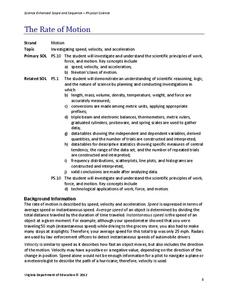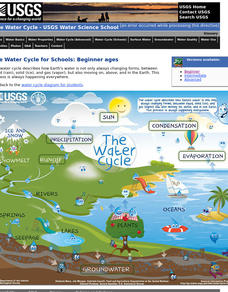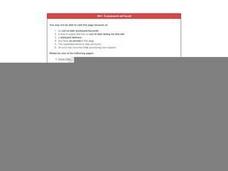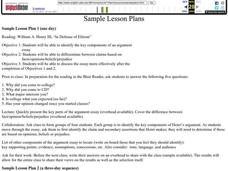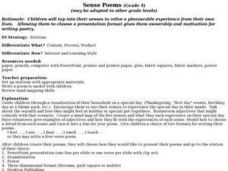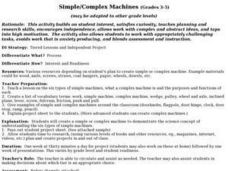Illustrative Mathematics
Voting for Two, Variation 4
After elections, the total amount of votes is not specified but the ratio of votes is. Your learners' job is to determine the fraction of votes John received above half of all votes. The problem can be solved abstractly or by other...
National Endowment for the Humanities
How "Grand" and "Allied" Was the Grand Alliance?
Learn more about the Grand Alliance with a scaffolded lesson plan that includes four activities. Class members use primary sources to complete a map exercise, understand the goals and objectives of each individual nation, and participate...
Virginia Department of Education
The Rate of Motion
How much time does it take to jump over three balloons? Pupils calculate the speed of tasks that require different motions. They determine motions for tasks such as walking, skipping, hopping, and jumping before creating a...
Virginia Department of Education
Solving Equations
Demonstrate the abstract process of solving equations by using algebra tiles as a concrete representation. Scholars begin by solving equations through the use of manipulatives. As they gain more confidence, they progress to...
National WWII Museum
On Leave in Paris: Maps as Primary Sources
Primary sources—even those that seem mundane—offer a window into those who experienced history. Using a Red Cross map offered to soldiers stationed in Paris after World War II alongside worksheet questions, scholars consider what life...
US Geological Survey
The Water Cycle for Schools: Beginner Ages
Explore a day in the life of a water droplet. An interactive infographic helps scholars learn how water cycles work from precipitation all the way around to condensation. Learners hover over each step of the cycle to read more as they...
Curated OER
Banking on the Future
Young scholars solve problems involving interest. In this investing lesson, students investigate the pros and cons of investing in a bank account and stocks. They differentiate between aggressive and conservative investments.
Curated OER
Parts Per Million
Young scholars perform serial dilution of food coloring experiment with partner, examine concentration levels, and differentiate parts per million (PPM) and parts per billion (PPB). Students complete pre-lab and post-lab questions and...
Curated OER
Recognizing Trade Definitions and Concepts
Students differentiate between imports and exports and examine data related to international trade. They view and discuss a PowerPoint presentation about international trade, define key vocabulary terms, answer discussion questions, and...
Curated OER
US Steel Gary Works: A Photographic Study
Middle schoolers formulate historical questions about the circumstances surrounding a photograph about the Gary Steel Works factories. They differentiate between historical facts and interpretation. They create a newspaper article about...
Curated OER
A Cosmic Cafeteria
Students indentify and differentiate between transit and surface food systems. Students measure energy that is released by various foods. Students compare and contrast cooking with solar energy on earth and what they might have learned...
Curated OER
The Constitution
Students determine that the rules that we follow in America were written in the Constitution. They study a copy of the constitution and discuss how it compares and differentiates from the plan the class has written. They recite our...
Curated OER
In Defense of Elitism
Students identify the key components of an argument essay. They differentiate between claims based on facts, opinions, beliefs,and prejudice. Students develop skills of critical thinking in this instructional activity.
Curated OER
Highlighting
Students locate and identify the relevant information that answers a research question. They read an article, and identify the key phrases that answer their research questions, differentiating between relevant and interesting information.
Curated OER
Haunting of Third Grade
Third graders discuss the meaning of the word "haunted." They watch as the teacher demonstrates using a sticky note to mark words that they find interesting in their reading. Students read chorally, then break into groups for a...
Curated OER
Safety
Students investigate the concept of voltage and electricity. They differentiate between an insulator and a conductor in the context of using electrical safety with the help of a doll house. Then students pretend the doll lives in a real...
Curated OER
Cell Reproduction and Inheritance
Students determine their inherited characteristics from their parents. In this biology lesson, students study the life of Mendel using an interactive website. They differentiate dominant and recessive characteristics.
Curated OER
Heart Healthy
Students assess their risk of heart disease. In this adult health lesson, students differentiate saturated and unsaturated fats. They discuss different heart healthy food ideas.
Curated OER
Living and Non-Living Things
Take a walk and observe living and non-living things on the way. Young scientists practice making valuable observations and draw the details. You could require that your students complete a T chart of living and non-living things...
Curated OER
Sense Poems
Learners explore 5 senses poetry. In this poetry writing lesson, students visualize a special day and brainstorm related vivid adjectives and phrases. Learners create mindmaps of the five senses to go with their visualization...
Curated OER
Airplane Design
Students design an airplane. In this transportation lesson, students review the parts of an airplane and their functions. Students work in groups to design their own airplane, reflect on the ideal plane, and compare it to their...
Curated OER
Paragraph Writing
Third graders receive Gummi hamburgers. They discuss parts and structure of a (real) hamburger. Students dissect the gummi hamburger and rearrange the pieces. Students discuss the problems that would be caused by this with a real...
Curated OER
Simple/Complex Machines
Young scholars make a simple machine. In this physics lesson, students learn about six types of simple machines and the purpose of each and brainstorm examples of simple and complex machines in the classroom. Young scholars create a...
Curated OER
Olympics (Grade 4)
Students research information about the current Olympic research. For this Olympic research lesson, students take a pre-test to determine their knowledge about the current Summer Olympics. They choose one of three areas to research and...




